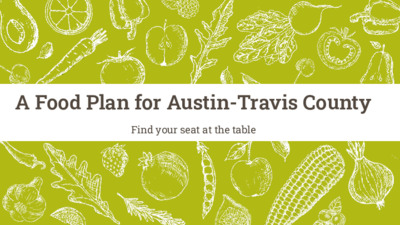Backup — original pdf
Backup

A Food Plan for Austin-Travis County Find your seat at the table Some Food for Thought Developing a Food Plan What is a Food Plan & why do we need one? ● A Food Plan sets clear Goals and Strategies to move toward a more equitable, sustainable & resilient food system ● The Food Plan builds on several other initiatives made by the County, City, and Communities to tackle key food system issues. ● The Food Plan centers equity and the lived expertise of those most impacted by the current food system Good to Know ● On June 2021 Austin City Council directed the City Manager to initiate a planning process ● Travis County Commissioners Court approved formal participation in the plan in fall 2022 ● A draft was released on March 18th , and has been reviewed by hundreds of community members. Link to full resolution Project Timeline Phase 0: Planning for the Plan Phase 1: Vision Development Phase 2: Goal & Strategy Development Phase 3: Review and Ground truthing September 2021 - January 2023 March - August 2023 September 2023 - February 2024 February - Summer/Fall 2024 We are here ● ● ● ● Building Community Awareness 📰 Release of State of the Food System Report 📚 Onboarding Planning Consultant⭐ Recruitment of Community Teams🚀 ● Website launch 📶 ● World Cafe’s ☕ ● ● ● ● Listening Sessions & Tabling at events 📞 Equity Grounding Workshops 🤝 Community Circles 👐 Selecting Issue Area Groups🍽 ● ● ● ● Issue Area Group Meetings 🏘 Develop Goals and Strategies 🎯 Review Goals and Strategies Develop a draft for the Food Plan 🖊 ● ● ● ● Community Review of Plan 👀 Council and Commissioner Review ⚖ Approval 👍 Adoption 🏁 Co-creating the plan ● Planning Team: Coordinating and managing all moving parts ○ Includes: ■ ■ ■ ■ ■ ■ City of Austin staff Travis County staff Consultant Team Equity Consultants Austin Travis Food Policy Board Executive Leadership Team ● Community Advisory Committee: Advisory body overseeing the planning process ● Issue Area Groups: Developing goals and strategies for the plan ● Community Food Ambassadors: Connecting the plan to our communities ● Broader community feedback: Provide input at different stages of the plan Food Plan Structure ● Vision: Describes and articulates our shared aim - the kind of future we agree we would like to move toward together. ● Objectives: The ends towards which the goals and strategies of the food plan will aim to achieve. ● Goal: A specific target or desired end result to meet one or more objectives. ● Strategy: A specific action we will take to achieve one or more goals. Will also require an Implementation Plan: A roadmap of how we will accomplish the goals and strategies in the food plan (TBD, when we get there!). Food Plan Vision We envision a just, accessible, and culturally diverse food system, built by undoing inequities, that supports and sustains inclusive thriving communities, healthy ecosystems, and solutions to climate change where everyone can reach their full potential now and for generations to come. Food Plan Objectives Sustain and restore living ecosystems including air, soil, water, and biodiversity. Invest in an equitable local food economy and workforce, including strengthening local food production, agriculture, processing & distribution, and food recovery. Improve emergency food distribution preparedness and response. Strengthen food supply chains to support community health and nutrition, the well-being of workers, the environment, and animal welfare. Support health and eradicate food insecurity through equitable access to nutritious and culturally relevant food. Act as a climate solution, considering the food system from field to fork and beyond. Build collective community power and coordination to strengthen the local food justice movement towards the fundamental human right to food. Goals and Strategies The food plan has 9 goals and over 50 strategies that seek to address many of the top concerns identified during the planning process: ● Goal 1 - Land: Increase local farmland for regenerative agriculture. ● Goal 2 - Ownership: Decrease barriers to farm ownership. ● Goal 3 - Livelihoods: Better conditions for food and farm workers. ● Goal 4 - Preparedness: Ensure food during emergencies. ● Goal 5 - Institutions: Strengthen local supply chains. ● Goal 6 - Access: Address food insecurity. ● Goal 7 - Food Recovery: Divert food from the landfill. ● Goal 8 - Pro-Climate/Pro-Health Foods: Decrease our carbon footprint. ● Goal 9 - Empower: Community supporting the implementation of the plan. Co-creating the plan Next Steps The Path to the Final Plan March 4 - March 11 March 18 - April 19 April May Summer 2024 Internal Review of Draft Plan Public Review of Draft Plan Public Review Meeting on April 3rd Creating the Final version of the Plan Present Plan to City Council and Commissioners Court Integrate public input into existing strategies CAC Approves Final Plan Implementation Begins Share your story! Celebrate with us! Join our final event ● Meet us this May 11th at For the Love of Parks: ○ Saturday, May 11th from 11am - 3pm at the Richard Moya Park ○ Stop by our table and join the celebration! Share your story! Stay in touch Subscribe to never miss a beat! ● Implementation will need even more people involved! ● Subscribe to Austin Food Notes, our monthly newsletter to receive timely updates! Thank you Visit our website to learn more about the plan! and read the full list of draft strategies. Questions? Email sustainability@austintexas.gov Important Resources and Information The State of the Food System 2022 ● Provides a brief history of the Austin Food System ● Provides the foundation for the Food Plan ● Each section contains: Overview, Trends and Challenges, Policy Actions, Key Questions & Facts Food Supply Chain Vulnerability Assessment ● describes issues that impact local food suppliers ● assesses the ability to rebound after a disaster for different sectors of the food system ● identifies strategies to decrease chronic vulnerabilities View full report here.